Where and how will look for extraterrestrial life after Mars
 Bashny.Net
Bashny.Net
Recent scientific findings open new prospects search for extraterrestrial life in the solar system. With an interval of only a month published a study that adds two more "water" of cosmic bodies. At present, liquid water on the surface can only be found on Earth; Mars sometimes appear strip of wet sand; on Saturn's Enceladus geysers powerful beat of the ocean under the ice through cracks in the ice crust; and his neighbor Titan ice erupt lava kriovulkany. Today in the number of sites where you can "touch" water added Jupiter's moon Europa, and the dwarf planet Ceres, in the main asteroid belt.
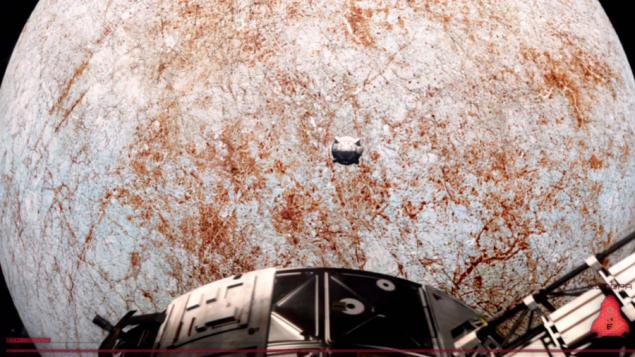
Europe has long been known as a water world, and it is not the first time attracted the attention of astrobiologists. But on the way researchers seeking protein forms of life, is not only a space, high radiation radiation belts of Jupiter, but thick ice crust. According to various estimates, the theory of "thick crust" suggests ice thickness of 30-100 kilometers. This distance is overcome by modern technology is more difficult than a billion kilometers vacuum.
The current view of the structure of Europe is formed according to the Voyager, Galilleo and observations from Earth. Europe - it is the smallest of the four "galilleevyh" Jupiter's moons. It has a high surface smoothness and brightness. The reason for this appearance - in the very young, on space standards, icy crust, which is updated due to tectonic processes similar to Earth. The smoothness of the surface is one of the indirect evidence of ice-ocean depth, which can reach 100 kilometers. Thus, water in Europe more than two times in the world. Below is a stone mantle, and in the center is supposed to metallic core.

It is believed that the red spots and stripes on Europe - is the result of emissions of water through cracks and breaks in the ice, and the color comes from iron and sulfur dissolved in the under-ice ocean. Just three months ago, scientists believed that such emissions originate in ancient times, and our time has stopped.

Unlike Earth, whose bowels are believed to be mainly heats radioactive decay, the main "heater" on Europe - a tidal influence of Jupiter. The attraction of the giant planet companion forces that change shape on the egg with the approach to Jupiter, then return to the further the ball. Of course, these fluctuations are insignificant difference "eggs" and a ball - just 30 yards, but the deformation across the satellite causes considerable heat, capable of supporting liquid water ocean.
In December 2013 long-term observations of Europe, using the Hubble Space Telescope and its ultraviolet spectrometer, brought an unexpected result - it turned out that the ice shell of the satellite is not monolithic. At times farther from Jupiter, in the ice at the South Pole of Europe opened a crack. Of them pulled out a giant jet of water, which rise to a height of 200 km, and then fall to the surface. Release rate is impressive - up to 5 tons of water per second.
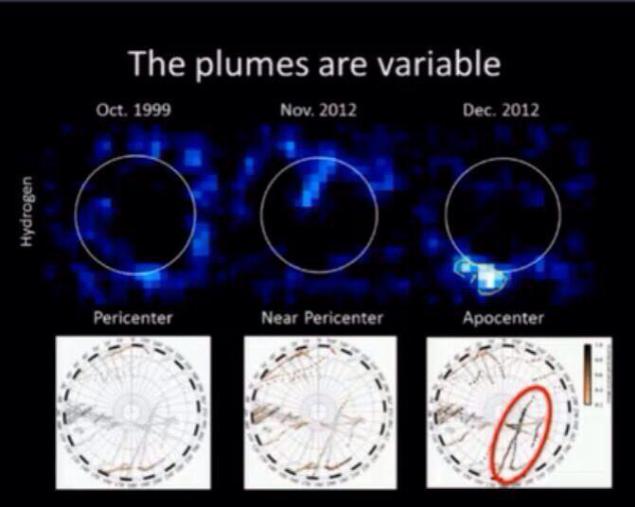
For comparison, the intensity of the geysers of Enceladus - 200 kg per second:
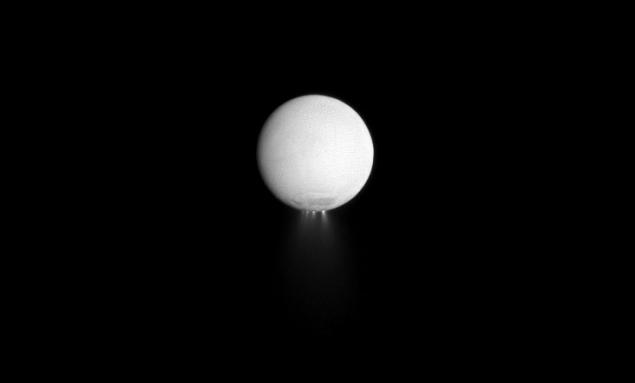
Really do not know the frequency of emissions on Europe for 15 years, found only two of the eruption, but no monitoring was carried out on a continual basis, therefore, they may occur more often.
Despite episodic emissions, new knowledge opens up new possibilities in the study of Europe, and the search for life in the under-ice ocean.
Previously considered various concepts and ideas to overcome the obstacles of ice. Among the proposals were quite exotic, like a nuclear reactor, which was supposed to run well and melted the ice under the submarine. But to begin to consider the idea of small impactor, which had hoped simply to drive deeper into the ice, no hope to get to a liquid ocean.

It came even before the test:
European study using a drill and the search for extraterrestrial life is devoted to low-budget film «Europa Report». Although the only merit of the film, I would call high-quality images of weightlessness on board the ship, we can not welcome an attempt to modern cinema step on Mars.
Due to the current Hubble discovery in general there is no need, as a manned expedition, and drilling operations. Now it is sufficient to plan a non-stop mission. The device should turn in a low orbit waiting to happen when the next eruption. At this point, it is enough to fly through a stream to collect samples of fresh water. While fishing in this way is difficult, but traces of microorganisms in the water (or rather it will be snow) can detect. The obtained results allow to estimate the probability of extraterrestrial life, and the chances of the presence of a giant squid in the ocean reasonable Europe.
Nearest expedition to Europe - JUICE - expected to send only in 2022, will reach it by 2030, so the intrigue will remain for a long time. Russia is somehow going to explore another satellite from the surface, but did not find the possibility of creating a machine with sufficient radiation protection, therefore refocus on Ganymede:

Launch is expected somewhere in 2024, ie can not wait.
In general, Europe seems to be the champion in the number of deep-space missions canceled it. Who flies to Jupiter probe NASA Juno, but research satellites in its scientific program is not included. It is hoped that the present discovery will spur space agencies and research organizations on a more active learning in Europe.
However, the search for extraterrestrial water is not necessarily fly to Jupiter. Second sensation presented Ceres, with an infrared telescope Herschel. Analysis of this dwarf planet that rotates between Mars and Jupiter, allowed scientists to the European Space Agency, to detect emissions of water and there.
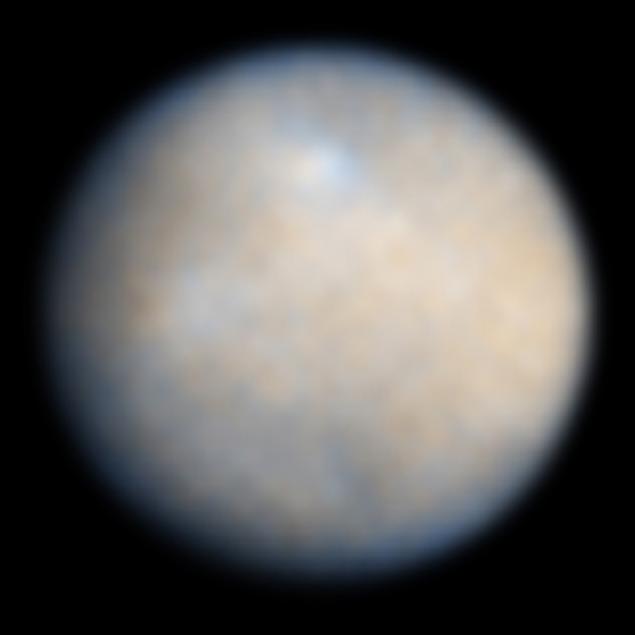
The truth is the allocation of water is much more modest, only 6 kg per second. But it was possible to precisely locate them. Emissions are made of two circular structures on the same latitude, but in different hemispheres:

Ceres - a large mysterious body in the asteroid belt. It was discovered in 1801, and managed for some time to be a planet until it was "demoted" to the asteroid. In 2006, she partially regained its title, hitting a number of dwarf planets of the solar system, along with Pluto, Eris, Makemake and Hanumea.

Ceres is the closest and smallest of the dwarf planets. At the same time we know about it not so much as about Mars or Jupiter's satellites. The most high-quality images obtained her telescope Hubble, they leave much to be desired.
Multispectral infrared shooting Keck Observatory in Hawaii allowed to reveal a little more surface detail.
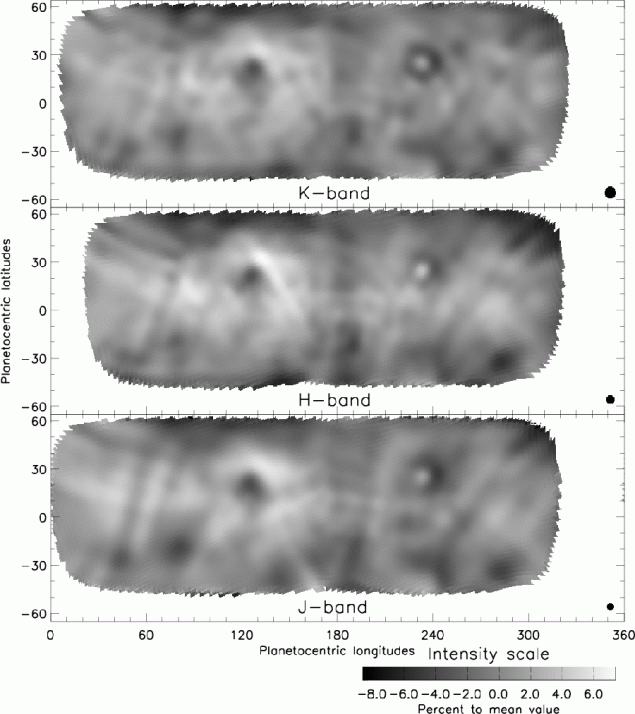
The average density of Ceres leads to the conclusion that most of it is made up of rocks, but the outer side is covered with a thick ice crust. So it was thought until recently, but now scientists have to adjust the model, suspecting the presence of a liquid ocean under the ice. It is believed that at Ceres water reserves are approximately equal reserves of fresh water on Earth.
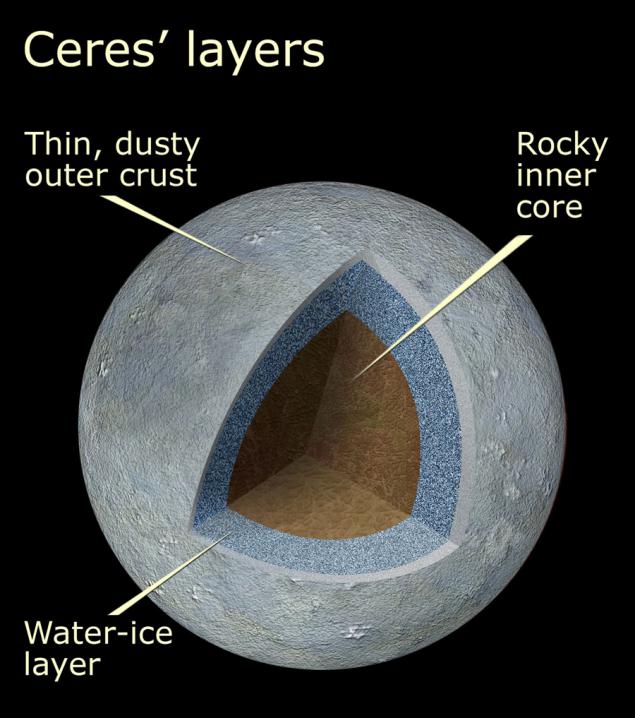
But due to the absence of information about the planet. While we do not even know what kind of spots from which water evaporates. This can be kriovulkany. If so, it will be just an incredible discovery. After Ceres is too small to radioactive decay in the core allowed to melt subsurface ocean. And there are no nearby giant body capable of causing significant tidal deformation. But all the ideas of the landing and drilling operations, which have been proposed for Europe, we can now try to Ceres. It has no deadly radiation and it is closer to the satellites of Jupiter, so it is easier to study. If absolutely dream, the Ceres - is the next potentially attainable object for manned flight, after Mars. In part, it is even easier to fly - no problem with the atmosphere and the weak gravity does not impede the rise.

But with all its alleged eruptions may be more prosaic. Ceres is the closest so-called & Quot; снеговой line & quot; - Limit beyond which water ice evaporates under the direct rays of the sun. Icy moons of Jupiter are not afraid of sunlight, but Ceres has every reason to behave like a comet. But this is not happening. It is believed that the ice on it evaporates (sublimates) because the surface is covered with a layer of regolith and hydrated minerals remaining from falling meteorites. In this case, it may be that the two points, where now stands the water - it's just a big fresh impact craters that have exposed deposits of ice, and "emissions", which registered a Herschel - this is the sublimation of ice under the influence of sunlight.
However, the intriguing fact that one of the "water" spots shines brightly in the ultraviolet, and the second - no. In this case, their origin may be different, and at least one of them may be a volcano.

For those who like me interested in Ceres, there's good news: Now it full steam rushes space probe Dawn. Despite the dissonant for the Russian ear the name, it worked perfectly during the study Ceres neighbor - the giant asteroid Vesta :

In early 2015 Dawn reach and Ceres, and this time you can safely make a list of the most anticipated events of space next year. I've got one more interest in Ceres, which is associated with the potential for terraforming Mars, but that's another story.
Source: habrahabr.ru/post/212517/

Europe has long been known as a water world, and it is not the first time attracted the attention of astrobiologists. But on the way researchers seeking protein forms of life, is not only a space, high radiation radiation belts of Jupiter, but thick ice crust. According to various estimates, the theory of "thick crust" suggests ice thickness of 30-100 kilometers. This distance is overcome by modern technology is more difficult than a billion kilometers vacuum.
The current view of the structure of Europe is formed according to the Voyager, Galilleo and observations from Earth. Europe - it is the smallest of the four "galilleevyh" Jupiter's moons. It has a high surface smoothness and brightness. The reason for this appearance - in the very young, on space standards, icy crust, which is updated due to tectonic processes similar to Earth. The smoothness of the surface is one of the indirect evidence of ice-ocean depth, which can reach 100 kilometers. Thus, water in Europe more than two times in the world. Below is a stone mantle, and in the center is supposed to metallic core.

It is believed that the red spots and stripes on Europe - is the result of emissions of water through cracks and breaks in the ice, and the color comes from iron and sulfur dissolved in the under-ice ocean. Just three months ago, scientists believed that such emissions originate in ancient times, and our time has stopped.

Unlike Earth, whose bowels are believed to be mainly heats radioactive decay, the main "heater" on Europe - a tidal influence of Jupiter. The attraction of the giant planet companion forces that change shape on the egg with the approach to Jupiter, then return to the further the ball. Of course, these fluctuations are insignificant difference "eggs" and a ball - just 30 yards, but the deformation across the satellite causes considerable heat, capable of supporting liquid water ocean.
In December 2013 long-term observations of Europe, using the Hubble Space Telescope and its ultraviolet spectrometer, brought an unexpected result - it turned out that the ice shell of the satellite is not monolithic. At times farther from Jupiter, in the ice at the South Pole of Europe opened a crack. Of them pulled out a giant jet of water, which rise to a height of 200 km, and then fall to the surface. Release rate is impressive - up to 5 tons of water per second.

For comparison, the intensity of the geysers of Enceladus - 200 kg per second:

Really do not know the frequency of emissions on Europe for 15 years, found only two of the eruption, but no monitoring was carried out on a continual basis, therefore, they may occur more often.
Despite episodic emissions, new knowledge opens up new possibilities in the study of Europe, and the search for life in the under-ice ocean.
Previously considered various concepts and ideas to overcome the obstacles of ice. Among the proposals were quite exotic, like a nuclear reactor, which was supposed to run well and melted the ice under the submarine. But to begin to consider the idea of small impactor, which had hoped simply to drive deeper into the ice, no hope to get to a liquid ocean.

It came even before the test:
European study using a drill and the search for extraterrestrial life is devoted to low-budget film «Europa Report». Although the only merit of the film, I would call high-quality images of weightlessness on board the ship, we can not welcome an attempt to modern cinema step on Mars.
Due to the current Hubble discovery in general there is no need, as a manned expedition, and drilling operations. Now it is sufficient to plan a non-stop mission. The device should turn in a low orbit waiting to happen when the next eruption. At this point, it is enough to fly through a stream to collect samples of fresh water. While fishing in this way is difficult, but traces of microorganisms in the water (or rather it will be snow) can detect. The obtained results allow to estimate the probability of extraterrestrial life, and the chances of the presence of a giant squid in the ocean reasonable Europe.
Nearest expedition to Europe - JUICE - expected to send only in 2022, will reach it by 2030, so the intrigue will remain for a long time. Russia is somehow going to explore another satellite from the surface, but did not find the possibility of creating a machine with sufficient radiation protection, therefore refocus on Ganymede:

Launch is expected somewhere in 2024, ie can not wait.
In general, Europe seems to be the champion in the number of deep-space missions canceled it. Who flies to Jupiter probe NASA Juno, but research satellites in its scientific program is not included. It is hoped that the present discovery will spur space agencies and research organizations on a more active learning in Europe.
However, the search for extraterrestrial water is not necessarily fly to Jupiter. Second sensation presented Ceres, with an infrared telescope Herschel. Analysis of this dwarf planet that rotates between Mars and Jupiter, allowed scientists to the European Space Agency, to detect emissions of water and there.

The truth is the allocation of water is much more modest, only 6 kg per second. But it was possible to precisely locate them. Emissions are made of two circular structures on the same latitude, but in different hemispheres:

Ceres - a large mysterious body in the asteroid belt. It was discovered in 1801, and managed for some time to be a planet until it was "demoted" to the asteroid. In 2006, she partially regained its title, hitting a number of dwarf planets of the solar system, along with Pluto, Eris, Makemake and Hanumea.

Ceres is the closest and smallest of the dwarf planets. At the same time we know about it not so much as about Mars or Jupiter's satellites. The most high-quality images obtained her telescope Hubble, they leave much to be desired.
Multispectral infrared shooting Keck Observatory in Hawaii allowed to reveal a little more surface detail.

The average density of Ceres leads to the conclusion that most of it is made up of rocks, but the outer side is covered with a thick ice crust. So it was thought until recently, but now scientists have to adjust the model, suspecting the presence of a liquid ocean under the ice. It is believed that at Ceres water reserves are approximately equal reserves of fresh water on Earth.

But due to the absence of information about the planet. While we do not even know what kind of spots from which water evaporates. This can be kriovulkany. If so, it will be just an incredible discovery. After Ceres is too small to radioactive decay in the core allowed to melt subsurface ocean. And there are no nearby giant body capable of causing significant tidal deformation. But all the ideas of the landing and drilling operations, which have been proposed for Europe, we can now try to Ceres. It has no deadly radiation and it is closer to the satellites of Jupiter, so it is easier to study. If absolutely dream, the Ceres - is the next potentially attainable object for manned flight, after Mars. In part, it is even easier to fly - no problem with the atmosphere and the weak gravity does not impede the rise.

But with all its alleged eruptions may be more prosaic. Ceres is the closest so-called & Quot; снеговой line & quot; - Limit beyond which water ice evaporates under the direct rays of the sun. Icy moons of Jupiter are not afraid of sunlight, but Ceres has every reason to behave like a comet. But this is not happening. It is believed that the ice on it evaporates (sublimates) because the surface is covered with a layer of regolith and hydrated minerals remaining from falling meteorites. In this case, it may be that the two points, where now stands the water - it's just a big fresh impact craters that have exposed deposits of ice, and "emissions", which registered a Herschel - this is the sublimation of ice under the influence of sunlight.
However, the intriguing fact that one of the "water" spots shines brightly in the ultraviolet, and the second - no. In this case, their origin may be different, and at least one of them may be a volcano.

For those who like me interested in Ceres, there's good news: Now it full steam rushes space probe Dawn. Despite the dissonant for the Russian ear the name, it worked perfectly during the study Ceres neighbor - the giant asteroid Vesta :

In early 2015 Dawn reach and Ceres, and this time you can safely make a list of the most anticipated events of space next year. I've got one more interest in Ceres, which is associated with the potential for terraforming Mars, but that's another story.
Source: habrahabr.ru/post/212517/
Tags
See also
10 facts about the search for extraterrestrial life
Triangle Karpman or how to act in life
Salmon grown on farms, antibiotics and mercury. How to determine what your salmon safe
The space race (32 photos)
Who are trilobites and how to look for them (24 photos)
Robert Waldinger What makes a good life? The lessons of the longest studies on happiness
Where and how to meet investors
Education as a way of liberation: lessons Babinskoe school
How to determine your metaphor of life
















